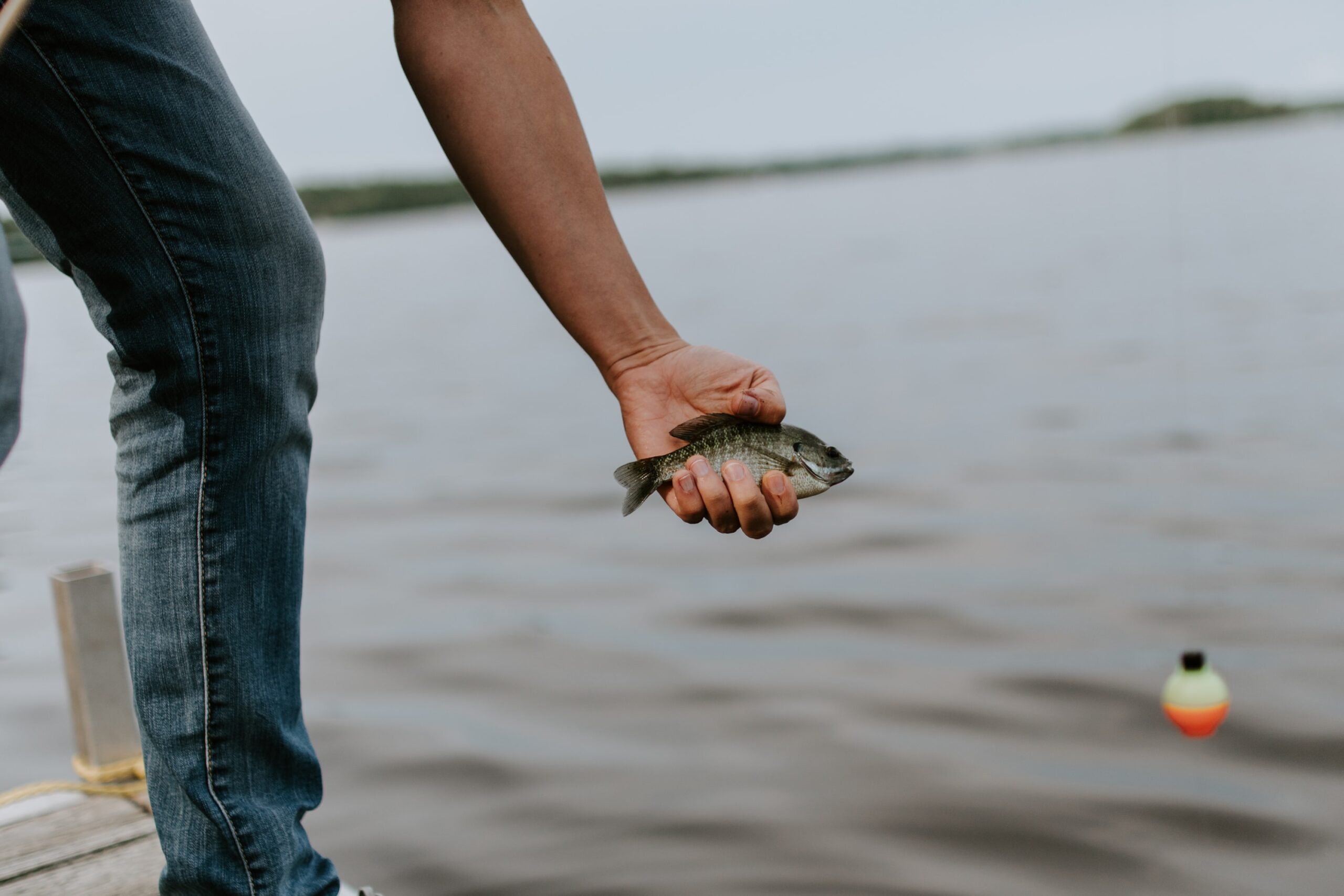This has been a requested topic for some time. Brim or sunfish are members of the Centrarchidae family. Most scientist includes bass as well as members of this family. There are about 30 different freshwater species. Most of the members in the brim or sunfish classification live in the same habitat which means you will have multiple different species occupying the same lake, or pond.
Catching bluegill is a great way to introduce fishing to kids so they are not cooped up in the house all day and get a chance to experience nature. Catching these fish is great fun for kids and anyone that wants to bring home some good fish to cook up. Brim typically ranges from 4 inches and can get up to 12 inches in length.
Bluegill (Brim) Habitat
All bluegill, crappie and sunfish are warmwater species with similar or overlapping habitats. Bluegill have a dorsal fin that is spined. If you are not careful as I have done on many occasion, you will get poked and it bleeds like no other. You also have to watch out for the anal fin. This has the same issue and can sneak up on you and get you will they are wiggling around. All bluegill are omnivorous so they will eat just about anything you throw at them.
Bluegill have small mouths so having smaller hooks is essential to catching them. This is mainly a lake fish but will inhabit streams, rivers, ponds and creeks. These fish prefer still water and are often found in shallow areas. This is what make catching bluegill a fun fish to catch with kids. Some times you can see them and do a bit of sight fishing, which is extremely exciting for kids to see how fishing actually happens when they are throwing the lure out and reeling it back in attracting the fish with the movement through the water. Typically, if there are large mouth bass in the water you may find bluegill.
Catching Bluegill
This is where the magic happens. Bluegill feed on just about anything from crayfish, insects, small minnows (for the larger fish), insects, worms, plant material and even snails! Fishing for these fish is fun, with surface and bottom fishing producing fish. They are strong fighters even though they are smaller fish. During the spring and summer months are when they are most active and closer to shore around their nests. Depending on the lake sometimes the nests are visible from shore as well.
Fishing from the shore
If you are fishing for these fun fish a live worm in shallow water and a bobber should do you well. When fishing with a bobber a split shot should be used, or no weight works as well. The least amount of resistance you can have on the line the better. Because the mouth is so small, make sure your hook is the same size you would use to catch trout or any other small mouthed ocean fish such as ocean perch. When casting a spinner bait or any other artificial bait, make sure to have a bit of distance on your cast and do a slow retrieve as we have found that this works best when fishing for these little guys.
Catching Bluegill Method 1
Slip Bobber Setup:
This setup is typically used with a cane or a single-pole to fish. You really don’t need a fishing reel to get these guys to bite. As long as you have a light line and some good bait, these fish are catchable.
This type of setup is typically used when you are fishing from the shore in the spring and summer months. Yes it will work during the early morning and dusk as well. You will need a bobber, cane pole, line slipshot and a hook. Those are the only things that you will need for this setup.
For a cane pole this is what we use:
When fishing for these bluegill in deeper water a different rig and a different rod and reel setup needs to be used. You may be able to get away with using the cane pole to fish early in the morning if you are fishing closer to shore and if you are not looking for a large bluegill, this can definitely work. If you are not interested in using the cane pole to fish and want to fish in deeper water.
Catching Bluegill (Brim) Method 2
Typically when fishing for bluegill in deeper water you will need to get the bait down toward the bottom but that isn’t heavy enough to distract the fish from a regular test bite into a feeding bit because there is too much resistance on the line. If this is the way you prefer to fish here are the tools we recommend.
- Rod – Any Ugly Stik or cheap rod that you can find or already own will do the trick.
- Reel – Reel should be extremely small as not a lot of line is needed and this is by far the easiest fish to catch and although it does put up a fight, the fight will not damage your reel.
- Fishing Line – Since these fish are tiny, the line should not go above the 6lb test. This is the max that I would use to catch them. Fluorocarbon from my experience is the best line to use. If you have monofilament that will work as well, just beware that the line is more visible in the water than fluorocarbon. I listed two below that are decent. I like to VANISH personally. I’ve used both numerous times. Good line and definitely can increase your catches
- Jig – This is what you will catch the largest fish on. Having the right size jig head is crucial when fishing for these small-mouthed fish. Anything that feels too heavy will spook the fish and it will let go of the bait immediately. If you are trying to get the rig down use the lightest jig head you have that will get you closer to the bottom. The jigs that I have used are from my local tackle shop so no recommendations on those. I would look for something that is lightweight with a light head that can still sink to the bottom. It needs to be as light as possible.
- Depthfinder – More than likely you already have one of these but if you are just starting out this one will do the trick. If you are in a small boat or even on a decent sized kayak, this will come in handy.
Flyfishing
Flyfishing is by far the rarest way to catch these fish but it is doable. This is definitely a great way to catch them. There are a whole group of If you are interested in learning how to fly fish for bluegill and other brim check out this article.
Size of Bluegill(Brim)
Bluegill do not tend to be that large but can be a decent fish to catch for kids. Most bluegill or sunfish tend to be around the 4 inches. Now if you are fishing in slightly deeper water around 20 to 30 feet, this is where you will encounter the larger fish up to 12 inches. We like to stay on the shore if we have all of the kids but when I go out by myself, I will paddle out to a ways from short and cast toward as close to the shore as I can and work the bait back towards me.
This has been a productive way to catch them for me. The larger fish 6 inches and above will move into shallow water during the morning and evening to feed and will be in deeper water during the rest of the day. There are large bluegill out there up to 12 inches and you will most likely catch them in that 20 to 30 ft of water area. The
Catching bluegill is a fun activity to do and if you are looking for a good fish to cook this is it. Easy for the kids to handle and is a great fish to use when teaching kids how to catch fish, clean the fish and cook it with the simplest of ingredients. Our 4 kids (1 daughter and 3 boys) love catching these fish and practicing their fillet skills when we are out camping near lakes and ponds.
Salt, pepper butter and lime go a long way on these small but tasty fish. Brim are great to catch and cook. There you have it a quick and concise guide on how to find these fish, how to catch them, some of the gear we have used in the past to catch them and how our kids cook them when they catch them. Our kids love to fish for them hopefully you and yours will too!

